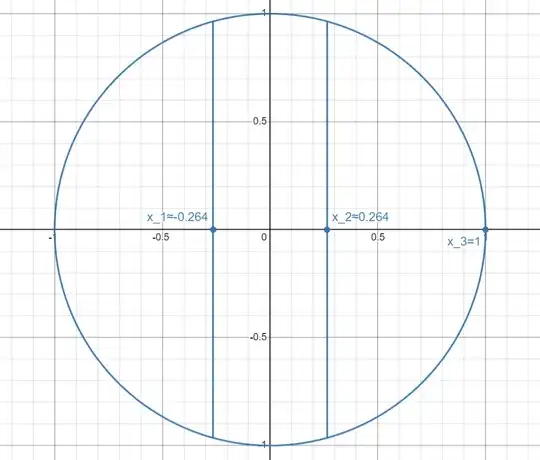For $n$ equal parts, the values of positive $x_k$'s are the solutions of the equation you wrote
$$\arcsin{(x_k)}+x_k\sqrt{1-x_k^2}=\frac{\pi}{2}-k\frac{\pi}{n}$$
I shall use $x=x_k$ and $A=\frac{\pi}{2}$$-k\frac{\pi}{n}$
A quite good approximation of the lhs is given by almost the simplest Padé approximant of it built around $x=0$, that is to say
$$\arcsin{(x)}+x\sqrt{1-x^2} \sim \frac{2 x \left(19 x^2-60\right)}{9 x^2-60}$$ whose error is $\frac{29 }{2800}x^7$.
To give an idea, consider the norm
$$\Phi=\int_{-1}^{+1} \Bigg(\arcsin{(x)}+x\sqrt{1-x^2}- \frac{2 x \left(19 x^2-60\right)}{9 x^2-60} \Bigg)^2\,dx=1.10061\times 10^{-4}$$
So, an approximation is given by the solution of the cubic equation
$$38 x^3-9 A x^2-120 x+60A=0$$
which has three real roots.
Using the trigonometric solution, the solution to be retained (positive and smaller than $1$) is given by
$$x=\frac{1}{38} \left(3 A-2 \sqrt{9 A^2+1520} \cos \left(\frac{1}{3}
\left(\cos ^{-1}\left(\frac{3 A \left(9
A^2-12160\right)}{\left(9 A^2+1520\right)^{3/2}}\right)+\pi
\right)\right)\right) $$
For example, for $n=7$, the results would be
$$\left(
\begin{array}{ccc}
\text{approximation} & \text{solution} \\
\pm 0.112437 & \pm 0.112437 \\
\pm 0.343474 & \pm 0.343478 \\
\pm 0.598821 & \pm 0.599061 \\
\end{array}
\right)$$
Another solution would be possible : expand the lhs as a series
$$\arcsin{(x)}+x\sqrt{1-x^2} =\sum_{m=0}^\infty a_m\, x^{2m+1}$$
Truncate to some order and use power series reversion to obtain
$$x=\sum_{m=0}^\infty b_m\, A^{2m+1}$$ where the first coefficients are
$$\left\{\frac{1}{2},\frac{1}{48},\frac{13}{3840},\frac{493}{645120
},\frac{37369}{185794560},\frac{4732249}{81749606400},\frac{90
1188997}{51011754393600}\right\}$$
